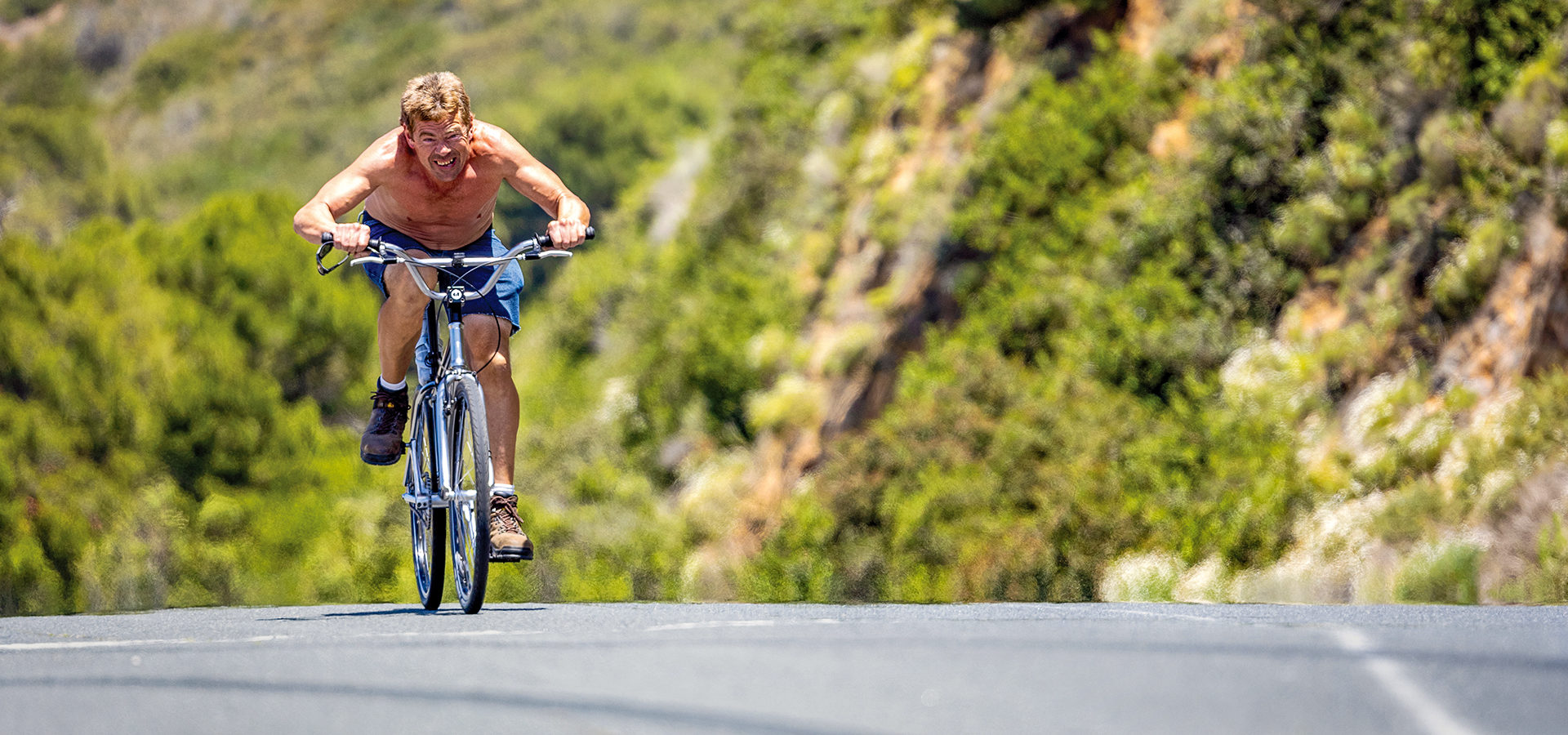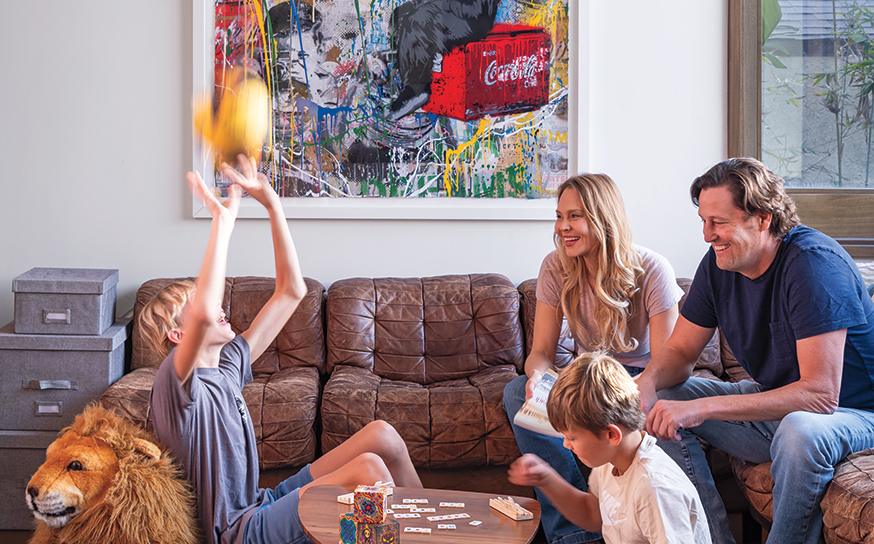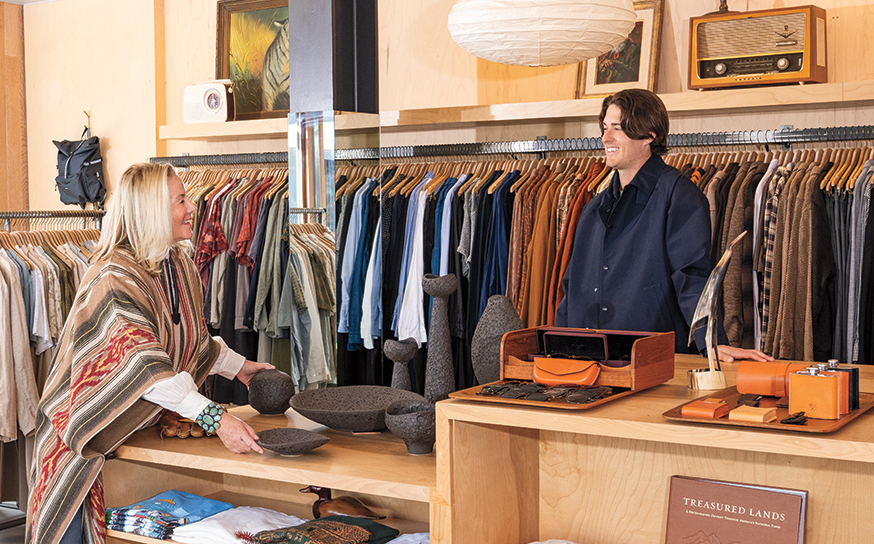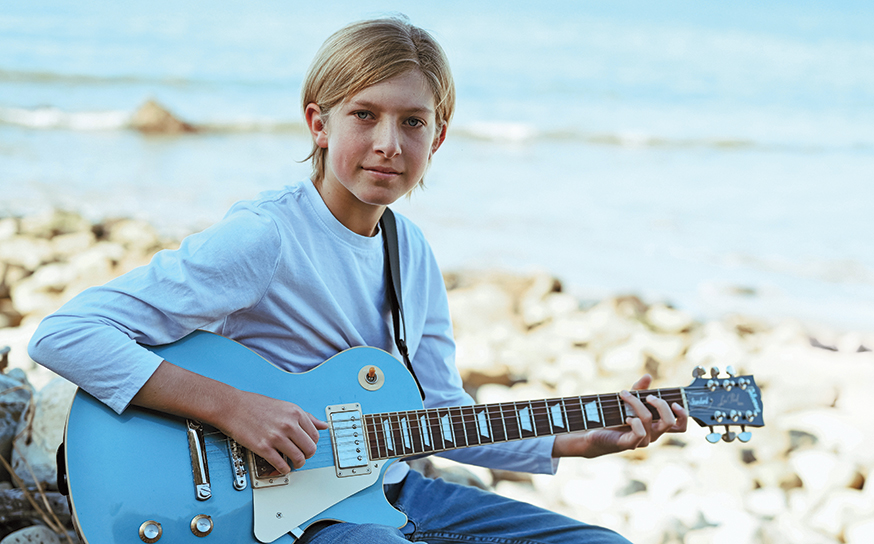Keith Floria is leaning against the railing on the patio of the Golden Cove shopping center along Palos Verdes Drive West, staring at the ocean, when I walk up to meet him on a sunny afternoon in early May. He’s holding on to the handlebars and seat of his shiny silver BMX bike (which I later learn is a GT 3816 single-speed street bike from the 1980s, weighing in at 31 pounds).
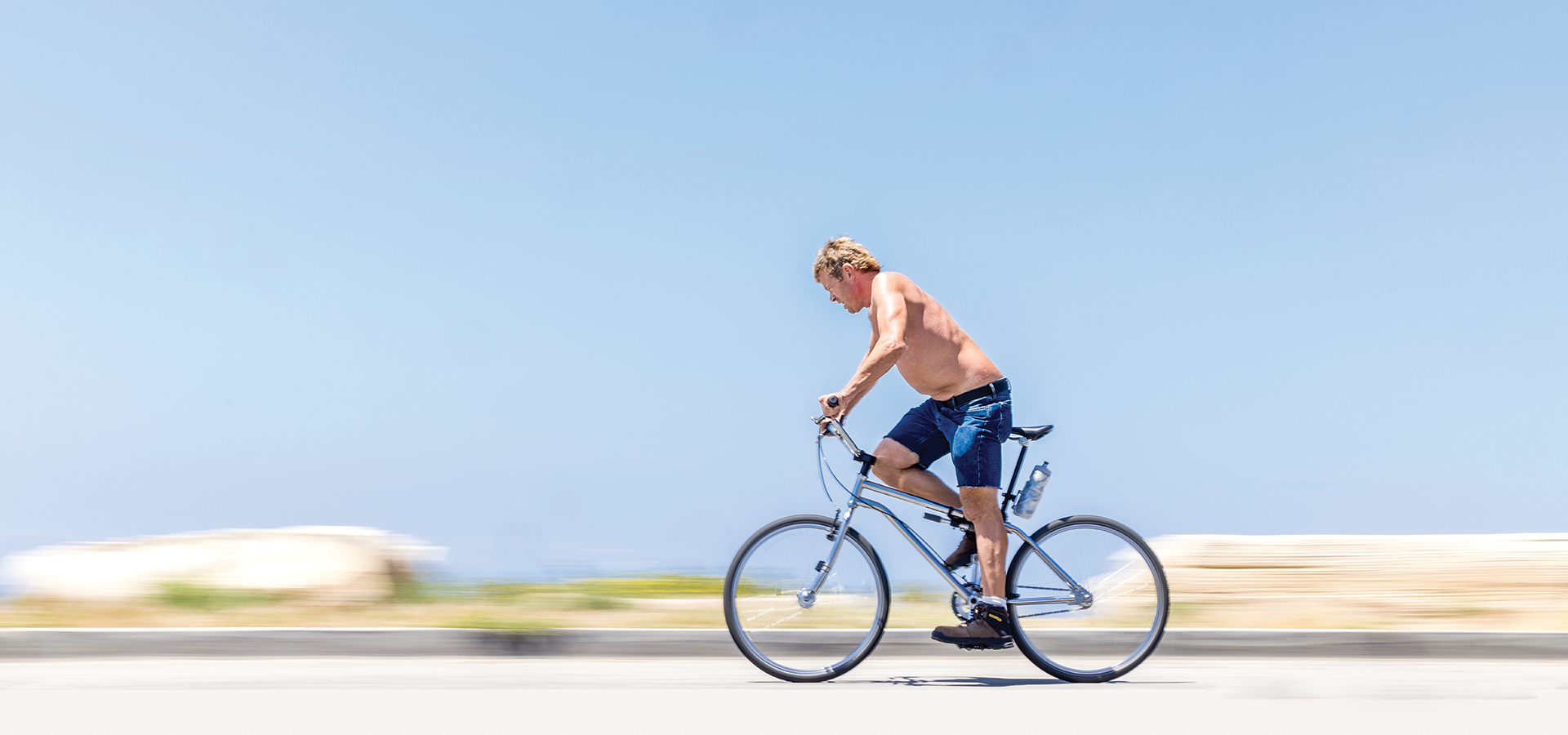
What strikes me immediately about this man, affectionately known throughout the South Bay as Shirtless Keith, isn’t his deeply tanned skin and unconventional cycling attire comprised of no shirt, Wrangler jean shorts, leather belt, white tube socks and Caterpillar leather work boots. It’s seeing him with two feet on the ground.
For the past several years, I’ve heard his name enthusiastically mentioned as being a local fixture and icon (he’s honked at regularly by drivers, praised by passersby, cheered on by fans and stopped at traffic lights). I’ve grown accustomed to seeing him whipping by at lightning speed on just about every thoroughfare—spanning the switchbacks at Marymount, Hawthorne Boulevard, Crenshaw Boulevard, Vista Del Mar and the Santa Monica Mountains.
As we grab a table, Keith gently rests his bike against the wall nearby and keeps a watchful eye on it as we chat. In the first few minutes we cover a few initial things: He doesn’t wear a watch by choice. He doesn’t own a cell phone, and he doesn’t have internet. He doesn’t have cable TV. He hasn’t driven a car in 18 years, and he hasn’t accepted a ride from anyone who has offered in years. He’s never broken a bone. He’s an avid baseball card collector (mainly 1960s rookie cards).
He’s gotten caught in Santa Ana winds, braved rain and overcast days, and clocked upwards of 52 miles per hour downhill. He’s not interested in getting a road bike or competing in the latest road race. He’s a humble man, an admitted nonconformist, with one major passion: cycling.
“I look forward each day to doing it, and it’s exhilarating,” he says. “The bike is a tool that enables me to do what I do.”
Keith, who turns 50 later this year, was born in Pittsburgh, Pennsylvania, and graduated from South Pittsburgh High School. He’s the oldest of three, with two younger sisters. He first migrated west to California in the late 1990s with his now ex-wife. He lived in Santa Monica for seven years before ultimately landing in his studio apartment in Harbor City.
Although he can’t quite explain how he fell into cycling—and now logs an average of about 350 miles per week—it’s partly about nostalgia and partly about not wanting to stop.
“It seems to help my mood a lot, and I feel good when I’m on the bike,” explains Keith. “I enjoy coming down the hill. In the 1970s, I remember being in the car in the backseat. The wind would blow, the music would play and it was like a short-term thrill. It’s kind of nostalgic when you’re coming downhill on the bike. I don’t like to be restricted with a helmet, and it’s like a roller-coaster effect. You don’t want it to end, and it doesn’t have to end.”
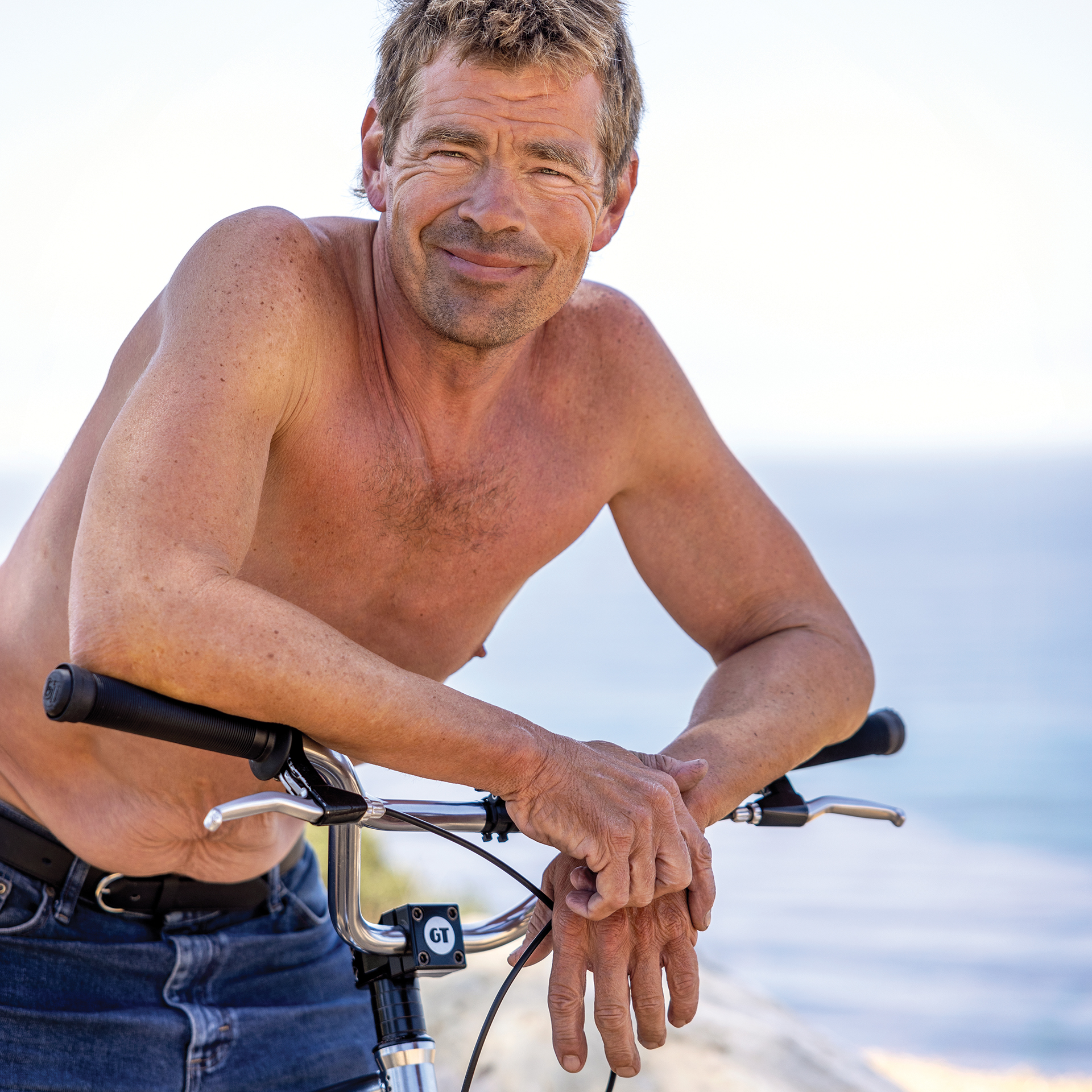
He walks me through a typical day, which begins with a hearty breakfast—a bowl of either Grape-Nuts or Raisin Bran—followed by the day’s ride and dinner he’s prepared himself, usually chicken and rice. While we speak, I’m distracted by a glare coming from the bike and reflecting straight into my eye. Later, when Keith gives me a detailed overview of his bike, I realize it’s a Pop-Tart perfectly curved around the seat post and attached with a small bungee cord.
He points out a bike pump underneath the frame, a water bottle holder and a small odometer attached to the bike. He then empties each pocket filled with emergency essentials: an extra set of tools, a replacement inner tube and a flattened Kellogg’s cereal bar. Although he doesn’t usually make a plan for each day’s route, he does have a few favorite spots including Del Cerro Park in Palos Verdes for the views, and a snack and soda at the Chevron station near Avenue I in Redondo Beach.
“What I manage to do—and I don’t know how long I’m going to be able to get away with it—I don’t have to look at a phone or a watch, because it doesn’t matter what time it is. I don’t think you can put a price on it.”
“Most of the time, I let the bike take me,” says Keith. “I think it becomes more of a responsibility and a duty if you have a plan. A lot of times I just come out and see what happens.” His latest and proudest achievement is riding more than 240 miles to Santa Barbara and back in the same day.
Keith helps with bike maintenance and repairs at a local bike shop and volunteers for a few hours every Friday around his neighborhood collecting trash (something he’s been doing for several years). He’s well aware of the swirling questions and bewilderment surrounding his lifestyle, why he eschews sponsors, and his selection of bike and workout gear. But he’s unfazed by it all.
“People ask me a lot of questions, but I’m fueled by it,” he says. “It’s very encouraging, and I don’t take it for granted. If I accept things from people—which I don’t, but if I did—if you eliminate the struggle, you might lose sight of the motivation. So it’s always been better to use my own resources. It’s not so much a pride thing, but if they are doing the work for you, you’re not so independent anymore.”
As far as his signature jean shorts, it’s about keeping it simple. “The less you have, the less you have to manage,” explains Keith, who has also been nicknamed Bootsy. “With these jean shorts, they are all the same color, the same shade. I don’t have to decide what I’m going to wear. And with no shirt, I don’t have to worry about laundry. I joke and tell guys that I have a shirt on layaway. I have one more payment to go.”
Joking aside, he reveals he’s had some challenging and undesired moments on the road—including breaking his handlebars, having the crank fall off his bike, getting road rash and being unbearably cold. But after all these years, the bike has taught him some valuable lessons about time, defying gravity and the relationship to resistance, and the meaning of life.
“I wake up, and that’s my goal. When I’m out there, I keep moving,” he says. “What I manage to do—and I don’t know how long I’m going to be able to get away with it—I don’t have to look at a phone or a watch, because it doesn’t matter what time it is. I don’t think you can put a price on it. I seem to have an abundance of time. I live for the moment. I think if you stick to one thing, like the bike, everything will fall into place.”






